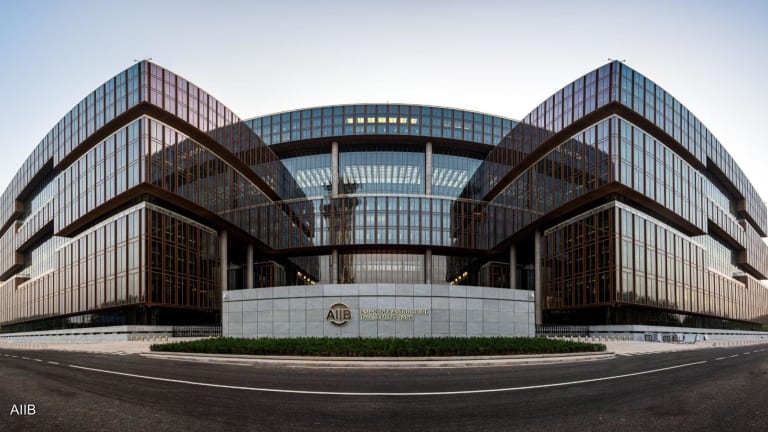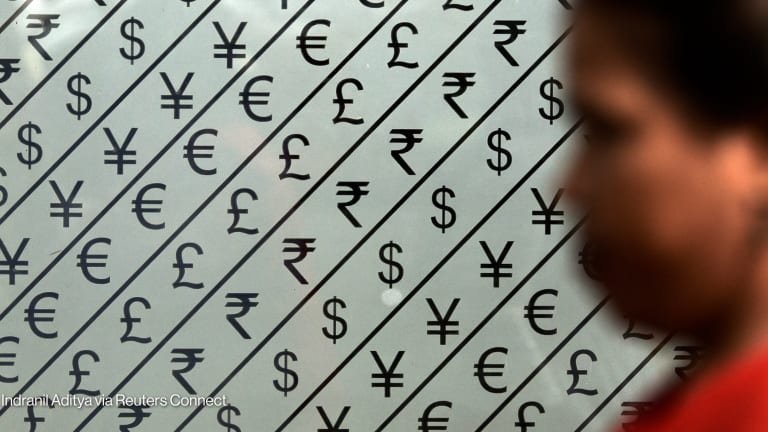AIIB's 5th anniversary: Where the money goes
The Asian Infrastructure Investment Bank invested $10 billion in 2020 — an increase of nearly 500% over five years. Devex explores the data.
The Asian Infrastructure Investment Bank celebrated its fifth anniversary in 2020, a year marked by new health and emergency response investments through the COVID-19 Crisis Recovery Facility and the development of its new 10-year corporate strategy for 2021-2030. Devex has analyzed AIIB’s approved projects over the past five years to understand its growth trajectory, its COVID-19 support, and to what extent its investments already align with the priorities of its new strategy: green infrastructure, regional connectivity and cooperation, technology-enabled infrastructure, and the private sector. The bank has grown relentlessly. It expanded from 57 founding members in 2016 to 103 members in 2020. Its current total investment is over $22 billion for 108 approved projects across 28 member countries, ranging from economic resiliency infrastructure to COVID-19 health infrastructure projects. It has not only invested in Asian countries but also in nonregional members including Egypt and Ecuador, with additional financing from other donors such as the Asian Development Bank and the World Bank. Jin Liqun, AIIB president, said he envisions greater expansion and investment in nonregional members in the coming years. These projects can be further explored using Devex’s funding search tool. Keep reading for Devex’s analysis. AIIB’s growing investments The bank’s investments grew by nearly 500% since 2016 — from eight approved projects worth $1.7 billion that year to 45 new approved projects worth almost $10 billion in 2020. In 2016, the bank kicked off with eight projects worth $1.7 billion across seven member countries — Azerbaijan, Bangladesh, Indonesia, Myanmar, Oman, Pakistan, and Tajikistan — but a third of that — $600 million — was allocated to Azerbaijan for the Trans Anatolian Natural Gas Pipeline Project to diversify gas export markets and improve energy supply security. To date, it remains one of the biggest projects in the bank’s portfolio. Another quarter — $400 million — of the bank’s initial investment went to Pakistan for two projects on motorway development and hydropower extension infrastructure. AIIB’s membership expanded significantly within its first year of operation, along with its investments. The number of approved projects increased by at least 88% from 2016 to 2017 and funding reached $2.5 billion. The bank also widened its reach beyond Asia for the first time with a $210 million project for solar panel infrastructure in Egypt. In 2018, approved project finance reached $3.3 billion for 12 projects. In 2019, it rose to $4.5 billion for 28 new projects. But it skyrocketed in 2020 with 45 new projects worth almost $10 billion in financing. This ended up being double the annual commitment that the bank had originally intended for 2020, according to a business plan released in December 2019, due to COVID-19. It approved 16 related projects worth $5.5 billion. Where does AIIB invest? Looking at all 108 projects approved over the past five years, worth $22 billion in total, roughly a quarter of funding went to India, with 20 projects worth over $5 billion for everything from transportation to flood management, solar energy, and COVID-19 health preparedness projects. In second place, Turkey received $2.1 billion for nine projects, followed by Indonesia with $2.1 billion for eight projects, Bangladesh with $1.8 billion for 11 projects, Pakistan with $1.3 billion for six projects, and China with $1.1 billion for four projects. Only two non-Asian member countries received AIIB financing: Ecuador got $50 million for one project and Egypt received $660 million for three projects. What does AIIB invest in? The 108 projects covered 10 sectors. The most funded sectors in AIIB’s work to date are economic resilience at $4.2 billion, including large investments through the COVID-19 Crisis Recovery Facility; transport at $4 billion, mostly for road connectivity and public transport; and energy at $3.9 billion, mostly for electricity generation through renewable sources. This aligns with the bank’s corporate strategy for 2021-2030, which aims to address connectivity by investing in major domestic and cross-border transport, digital, energy, and water networks. There were also five projects relevant to its technology-enabled infrastructure priority, tagged under information and communications technology. These ranged from a health care technology fund and multifunctional satellites to fiber optic and broadband connectivity projects. The current portfolio also has three projects related to the green infrastructure priority, focusing on climate resilience partnerships. What are AIIB’s biggest programs? Aside from COVID-19 projects, two energy projects were the most funded in the bank’s five years of operation. With $600 million of AIIB investment each, they are over 200% bigger than the average project size — again, excluding COVID-19 projects — of $180.1 million. The Tuz Golu Turkey Gas Storage Expansion Project, which will expand underground gas storage capacity in Turkey, has an approved budget of $600 million from AIIB, complemented by significant funding from the World Bank, the Islamic Development Bank, BOTAŞ Petroleum Pipeline Corp., and other commercial sources. The Trans Anatolian Natural Gas Pipeline Project in Azerbaijan also received $600 million from AIIB, with billions more from the World Bank, the European Bank for Reconstruction and Development, the European Investment Bank, and commercial sources. By strengthening its connectivity, the project should allow Azerbaijan to integrate with regional and European energy markets, diversifying its gas export markets and improving the energy supply to Turkey and southeastern Europe. Coronavirus-related projects so far have had an average size of $341.2 million, but four COVID-19 Active Response and Expenditure Support programs received significantly more. These programs, in India, Indonesia, Kazakhstan, and the Philippines, each received a $750 million allocation and collectively account for more than half of AIIB’s total COVID-19 funding. The projects aim to help governments address the health, social, and economic effects of the pandemic. It is financed through AIIB’s COVID-19 Crisis Recovery Facility with co-financing from the Asian Development Bank’s Countercyclical Support Facility COVID-19 Pandemic Response Option. Of the 16 COVID-19 projects approved in 2020, 12 were co-financed by other donors, including ADB, the World Bank, KfW Entwicklungsbank, and EBRD. How does AIIB’s future financing look? In addition to the approved projects, AIIB also reports on those that it might finance. The inclusion of a project in the list does not guarantee funding approval from the bank. Keep tabs on the bank's future financing on Devex's funding platform. Currently, there are 46 projects, with a total proposed financing of $11.4 billion from the bank. India has the most at $5.1 billion — 45% of the total proposed funding — for 16 projects, followed by Bangladesh at $1.6 billion for five projects and Pakistan at $897 million for four projects. By sector, the biggest chunk is allocated to transport at $5.1 billion for 17 projects, followed by energy at $2.2 billion for nine projects and water at $1.9 billion for seven projects. Three COVID-19 projects in Bangladesh, Thailand, and Sri Lanka, with aggregated financing of almost $1 billion, were also proposed. The COVID-19 Active Response and Expenditure Support Program in Thailand is the largest proposed project with $500 million from AIIB and an additional $1.5 billion from ADB. The program will help address the social and economic effects of the pandemic by expanding the government’s social assistance programs and providing needed social expenditures. Raquel Alcega contributed reporting to this article. For access to in-depth analysis, insights, and funding opportunities from over 850+ sources — combined with Devex Pro news content — sign up for Pro Funding or get in touch to learn about our Pro Funding group options.
The Asian Infrastructure Investment Bank celebrated its fifth anniversary in 2020, a year marked by new health and emergency response investments through the COVID-19 Crisis Recovery Facility and the development of its new 10-year corporate strategy for 2021-2030.
Devex has analyzed AIIB’s approved projects over the past five years to understand its growth trajectory, its COVID-19 support, and to what extent its investments already align with the priorities of its new strategy: green infrastructure, regional connectivity and cooperation, technology-enabled infrastructure, and the private sector.
The bank has grown relentlessly. It expanded from 57 founding members in 2016 to 103 members in 2020. Its current total investment is over $22 billion for 108 approved projects across 28 member countries, ranging from economic resiliency infrastructure to COVID-19 health infrastructure projects.
This story is forDevex Promembers
Unlock this story now with a 15-day free trial of Devex Pro.
With a Devex Pro subscription you'll get access to deeper analysis and exclusive insights from our reporters and analysts.
Start my free trialRequest a group subscription Printing articles to share with others is a breach of our terms and conditions and copyright policy. Please use the sharing options on the left side of the article. Devex Pro members may share up to 10 articles per month using the Pro share tool ( ).
Janadale Leene Coralde works as a contributing analyst for Devex. Based in Manila she reports on development donors activities and designs funding data visualisations. She has a degree in political economy, specializing in international relations and development, and has previously worked as a researcher for Chemonics, the REID foundation, and the Philippines House of Representatives.
Miguel Tamonan is a Senior Development Analyst at Devex, where he analyzes data from public and private donors to produce content and special reports for Pro and Pro Funding readers. He has a bachelor’s degree in Political Science with a Major in International Relations from the Polytechnic University of the Philippines.









